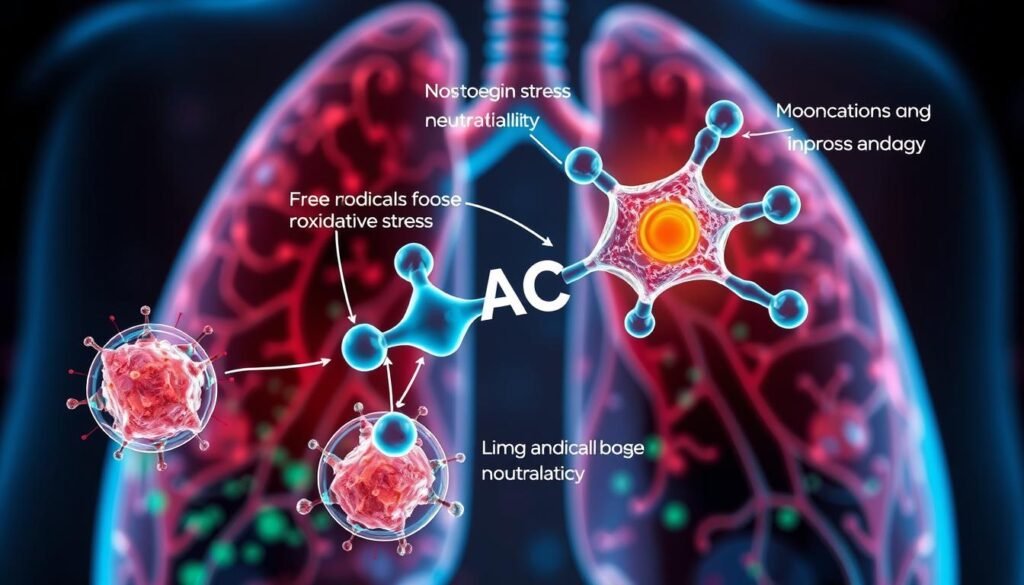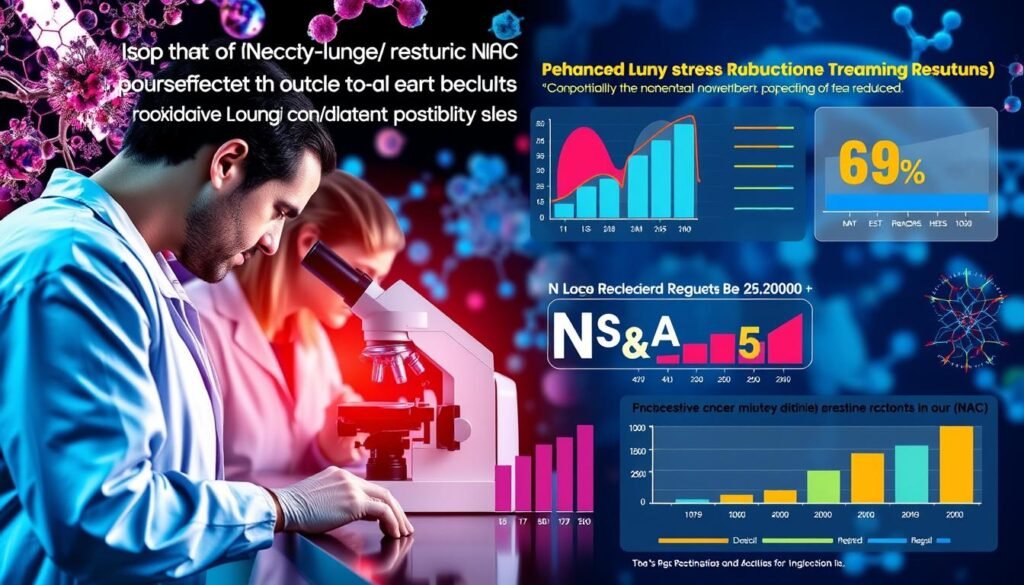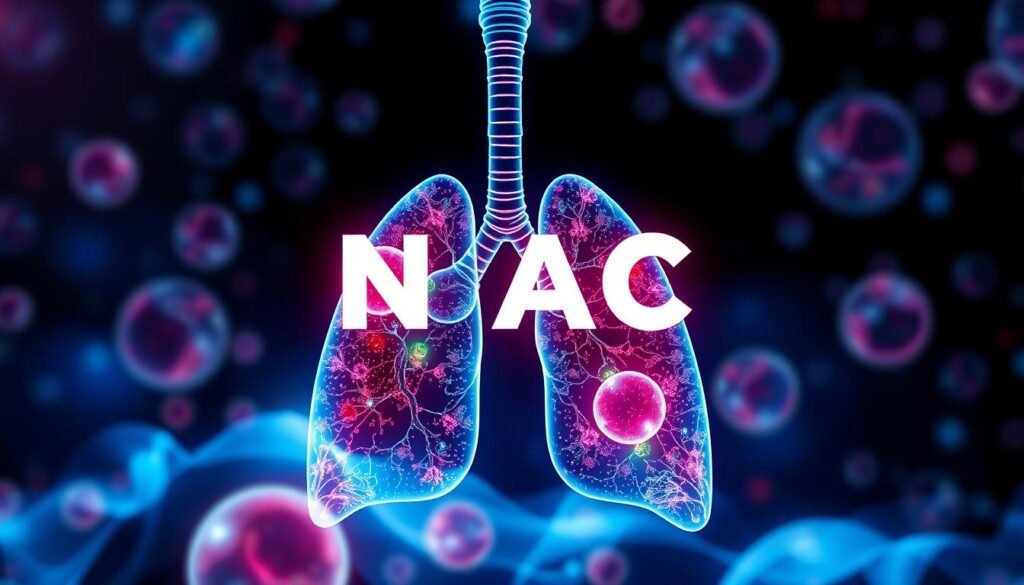Every year, over 230,000 new lung cancer cases are reported in the United States. This makes finding effective treatments critical. N-acetylcysteine (NAC) is gaining attention as a way to improve treatment and recovery. This article looks at NAC’s role as an antioxidant. It also explores its use in immunotherapy and targeted therapy, and promising research on its benefits.
NAC’s antioxidant properties could help patients undergoing various treatments. New research shows how effective NAC might be. Learning about NAC helps us see its potential in advancing lung cancer care. To discover more about new treatments, check out this comprehensive resource.
Key Takeaways
- NAC shows promise in enhancing treatment outcomes for lung cancer patients.
- The antioxidant properties of NAC may play a crucial role in recovery.
- Research continues to explore the integration of NAC with immunotherapy and targeted therapies.
- Understanding lung cancer treatment options can empower patients and families.
- Ongoing studies are essential for uncovering NAC’s full potential in lung cancer therapy.
Introduction to N-acetylcysteine (NAC)
N-acetylcysteine, often called NAC, is a supplement of cysteine. It’s an amino acid that the body may need more of under certain conditions. The FDA approved NAC in 1963 to treat heavy mucus in the lungs. It has become well known for treating acetaminophen overdoses. This shows its wide use in healthcare.
NAC stands out for its strong antioxidant properties. It boosts glutathione levels, which helps fight off harmful oxygen molecules (ROS). By doing this, NAC shields cells from damage due to oxidative stress. This is key not just for sudden illnesses but also for long-term conditions. For instance, it helps with lung problems like COPD and chronic bronchitis.
NAC is also being looked at for mental health benefits. It might help with bipolar disorder and schizophrenia symptoms. Its role in reducing oxidative damage is helpful for the kidneys and liver too. This is especially true when dealing with toxins.
NAC’s many uses highlight its importance in modern healthcare. Its potential in cancer treatment is especially exciting. It protects cells and helps manage important body processes. This could make a big difference in how patients recover.
Understanding Lung Cancer: Types and Statistics
Lung cancer is a leading cause of cancer deaths in the U.S. There are two main lung cancer types: non-small cell lung cancer (NSCLC) and small cell lung cancer (SCLC). Both types have unique features and challenges for doctors.
Many lung cancer cases are found late. The American Cancer Society found that in 2020, about 66% were late-stage diagnoses. This shows we need better screening and early detection for those at risk.
Smoking is a big risk for lung cancer. So is secondhand smoke and pollution. These things make non-small cell lung cancer more likely. Past lung diseases also play a role, according to the International Lung Cancer Consortium.
Knowing the statistics about lung cancer is vital. It helps patients, doctors, and researchers. Good data guides treatments and how to prevent lung cancer. Promoting risk factor knowledge and early detection can lead to better results.
| Type of Lung Cancer | Percentage of Cases | Risk Factors |
|---|---|---|
| Non-Small Cell Lung Cancer (NSCLC) | 85% | Smoking, secondhand smoke, pollutants |
| Small Cell Lung Cancer (SCLC) | 15% | Smoking, genetic factors |
NAC and Lung Cancer: Effects on Treatment & Recovery
N-acetylcysteine (NAC) helps patients in their fight against lung cancer. Experts are looking into how it affects treatment and healing. It is known for boosting protection as an antioxidant. Yet, its benefits in clinical settings are complex.
Some studies show NAC can lessen chemotherapy side effects. This could make life better for patients. On the other hand, high doses may help lung cancer grow in some cases. This confusing outcome needs careful study.
The goal is to improve how treatments work. Doctors want to personalize recovery plans with NAC. They consider how it interacts with other treatments.
NAC is often given through an IV. The dose can change to meet different health needs, including for lung cancer. It supports detox and lowers stress from oxidation. But, everyone reacts differently, showing why custom treatment matters.
Mechanism of Action of NAC
N-acetylcysteine (NAC) is important in treating lung cancer because of how it works. It mainly uses its antioxidant powers to manage stress in cells. This action affects the complex behavior of cancer.
One important way NAC works is by boosting the making of glutathione, a key antioxidant. Glutathione protects cells from harm caused by oxidative stress.
Antioxidant Properties of NAC
NAC’s antioxidant strength is well-known. It improves the levels of glutathione inside cells. Glutathione acts as a protective barrier against oxidative stress.
This stress is often worse in cancer cases. By increasing glutathione, NAC helps balance cell health and fights off damage from free radicals.
Impact on Reactive Oxygen Species
Reactive oxygen species (ROS) have a big role in cancer growth. NAC adjusts their production and impact around tumor cells. This might affect how cancer cells grow or survive.
While low levels of ROS can make tumors grow, high levels can kill cancer cells. NAC’s ability to control ROS levels might be key in new cancer treatments.

Clinical Applications of NAC in Cancer Treatment
N-acetylcysteine (NAC) is gaining interest for its role in cancer care. It helps lessen the harsh side effects of cancer treatments like chemotherapy. Studies show NAC can reduce liver toxicity and neuropathy. These conditions greatly affect patients’ wellbeing.
NAC might help with side effects mitigation, but results vary. It seems to reduce mucositis, a painful result of chemotherapy. More research is needed to confirm the best way to use NAC in cancer therapy.
| Study Focus | NAC Impact | Results |
|---|---|---|
| Effects on Liver Toxicity | Potential Reduction | Mixed results, further studies required |
| Neuropathy Alleviation | Alleviated Symptoms | Results show some benefits |
| Mucositis Management | Promising Outcomes | Needs large-scale validation |
| Contrast-Induced Nephropathy | Notable reduction rates | 35% in control vs. 8% in high-dose NAC group |
A review of several trials found fewer flare-ups in COPD patients after NAC treatment. It suggests NAC could be more explored within cancer care.
Understanding NAC’s role in cancer better requires thorough studies. A detailed study looks into NAC’s antioxidant qualities. It explains how these could help with chronic illnesses.
Evidence Supporting NAC in Lung Cancer
Studies on N-acetylcysteine (NAC) show its potential in lung cancer treatment. These studies reveal how NAC affects treatment outcomes. This adds important information to lung cancer research.
Research Findings on NAC and Treatment Outcomes
Low doses of NAC may improve treatment results. For example, NAC might make chemotherapy more effective against lung cancer. However, larger studies give contrasting outcomes. Some show a rise in cancer recurrence after using NAC.
Early findings suggest NAC could help lower cancer indicators. This points to its possible role in lung cancer management. But using too much has its downsides. Excess NAC boosted tumor growth in some mouse studies.
Long-term NAC use led to tumors in many mice. This highlights the need for careful use of antioxidants in cancer therapy.

Potential Risks and Controversies
Using N-acetylcysteine (NAC) in cancer treatment brings up many concerns about its risks. The antioxidant debate is a key topic. This is because antioxidants can affect tumor cells in different ways. Some research indicates antioxidants might shield tumor cells from chemotherapy’s harmful effects.
This sparks important discussions on their use in treating cancer. Outcomes can differ greatly, depending on the patient and the type of tumor. This means a detailed review is needed before using NAC in treatment plans.
Concerns with Antioxidants in Cancer Therapy
NAC is known for its benefits, like treating acetaminophen overdose, yet its use in cancer therapy raises concerns. Studies looking at large groups of patients found side effects like dyspepsia and diarrhea in about 10.2% of NAC-treated patients. These numbers are close to those seen in placebo groups, but the broader implications of antioxidants are still debated.
The BRONCUS study with COPD patients found no significant difference in side effects between NAC and placebo. There wasn’t clear evidence of drug-related problems.
Another key issue is NAC’s possible role in enhancing oxidative stress in cancer patients. It’s unclear if higher doses of NAC (>600 mg/day) lead to more side effects. Ongoing research is key to understanding how NAC works with cancer treatments. Studies on lung cancer and NAC use are particularly important. They take into account the risks of smoking and other environmental factors on cancer. For more on cancer and smoking, visit here.
| Study | Population | NAC Dosage | Adverse Effects |
|---|---|---|---|
| Stey et al. | 2540 patients with chronic bronchitis | 400-600 mg/day | Dyspepsia, diarrhea (10.2% treated vs. 10.9% control) |
| Grandjean et al. | Studies from 1980 to 1995 | 400-1200 mg/day | Mainly gastrointestinal, no notable differences |
| BRONCUS | 523 COPD patients | Not specified | 2809 adverse events, not drug-related |
| Cazzola et al. | Meta-analysis of 13 studies | High doses (> 600 mg/day) | No significant increase in adverse effects |
Integrating NAC into Current Treatment Protocols
Adding NAC to lung cancer treatments is a key advance in personalized medicine. The oral form of NAC has a bioavailability of 4% to 10%. This presents challenges in making it an effective treatment. Also, doses under 1200 mg per day might not be very beneficial. This shows the need for well-defined treatment plans.
Studies say high-dose NAC is safe for managing inflammation, like in cystic fibrosis. But, when we use it for lung cancer, we must watch patients closely. NAC stays in the body for about 6.25 hours. This detail is crucial when deciding how often patients should take it. Side effects like nausea and diarrhea may make patients less willing to stick with the treatment. This underlines why therapies must be suited to each person.
Recent reviews point out NAC’s role in lessening oxidative damage and potentially slowing tumor growth. Hence, when we include NAC in lung cancer treatments, we should tailor doses. This approach maximizes antioxidant advantages and reduces risks.

Identifying which patients would gain most from NAC is important as research moves forward. Oncologists aim to better patient outcomes and life quality by using personalized treatment methods.
| Research Focus | Findings | Implications for Treatment Protocols |
|---|---|---|
| Bioavailability of NAC | 4% to 10% | Necessitates higher doses for efficacy |
| Recommended Dosage | At least 1200 mg/day for significant benefits | Redefines minimum treatment standards |
| Common Side Effects | Nausea, vomiting, diarrhea | Requires patient education and monitoring |
| Half-Life | 6.25 hours | Influences dosing intervals |
| Clinical Application | Safe in modulating inflammation | Therapeutic potential in personalized medicine |
Lung Cancer Screening and Early Detection: The Role of NAC
Finding lung cancer early is key to helping patients live longer. Screening with a low-dose CT scan is crucial for spotting the disease sooner. Current studies show that N-acetylcysteine (NAC) might make these screenings even better.
NAC could improve lung health, which might make screenings more successful. Some research thinks adding antioxidants like NAC could make CT scans work better. Yet, we need to learn more about how NAC affects lung cancer screening.
However, we should be careful about NAC’s benefits. NAC helps increase important antioxidants in the body and can clear mucus. But, there are worries about its side effects in certain cases. This shows the clear need for more detailed studies on how NAC can help in lung cancer screenings.
Conclusion
In conclusion, N-acetylcysteine (NAC) shows potential in lung cancer recovery, but its effectiveness is not fully proven. While some studies show NAC can improve treatment for certain cancers, others suggest it might speed up tumor growth in some cases. Specifically, NAC has been found to increase lung adenocarcinoma growth in certain mice.
The role of NAC in cancer therapy is complex and needs more study. Researchers must focus on how dosage, timing, and cancer type affect NAC’s role in treatment. This will help us understand how to use NAC more effectively. More research is needed to explore NAC’s complex effects on cancer.
It’s important to recognize NAC’s limits and benefits as we work to better cancer treatments. Through more research, we can gain clearer insights into NAC. This could improve outcomes for lung cancer patients and lead to new treatment methods.
To learn more about antioxidants in cancer and NAC’s controversial impacts, read the detailed study here.